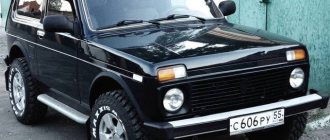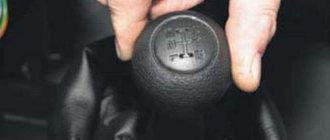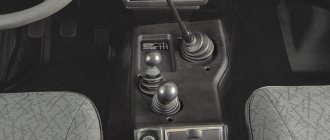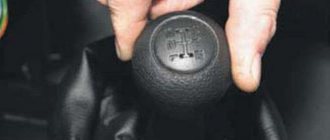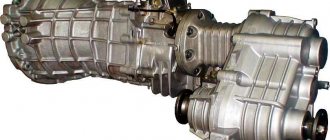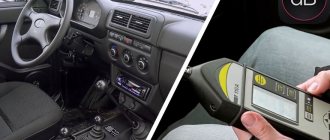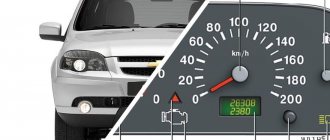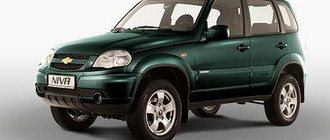The VAZ 2121, in other words, “Niva”, entered mass production in the 70s of the last century. This car belongs to the class of off-road passenger cars. In the history of the domestic automobile industry, Niva became the first car whose design used all-wheel drive. Let's take a closer look at the transmission device. This should be done in order to understand why, given its almost 40-year history, the Niva transmission differs from many other similar vehicles equipped with all-wheel drive and the ability to shift in the classical way or using a viscous coupling.
The transmission in the Niva family (2121, 2131) is designed in such a way that all-wheel drive is supplied to 4 wheels. Also characteristic is the presence of a center differential. The transmission includes a gearbox, a transfer mechanism, a pair of cardan shafts, and both axles. A characteristic feature of the 2131 model is its elongated body. Otherwise, the main similarities with the first model can be traced throughout. Torque is transmitted from the engine through the gearbox to the transfer case, and it, in turn, transmits torque to the axles.
Then it goes through the cardan shafts to the gearboxes. The front gearbox transmits torque to the wheels through the differential and constant velocity joints. Likewise for the rear, also protruding, driving wheels. It is precisely because the torque is distributed to 4 wheels simultaneously that the drive is called full drive. The designation is as follows – 4WD. Another domestic car, designed on a similar principle to the Niva, is the UAZ.
Differential
This mechanism is a kind of distributor of traction forces coming from the motor to the wheels. An important feature is that the latter have the ability to rotate at different speeds. The importance of having a differential mechanism is due to the fact that during turning maneuvers, the wheel located inside makes fewer revolutions when compared with the number of turns of the outer wheel.
In the absence of a differential mechanism, this would cause detrimental consequences, such as wear and damage, because the result would be the following: when turning, one wheel would be in a slip state, and the second would simply rub against the road surface. The design features of the Niva transmission provide for the presence of 3 differentials. They are located in each of the bridges and in the transfer mechanism.
When the car moves on a flat road and in a straight line with differentials, the traction force is divided equally between all 4 wheels. If there is insufficient adhesion of the wheels to the surface or slipping occurs, the differentials will redistribute the load on the slipping and sliding wheel so that the first receives more force, and the second, accordingly, less.
We have already mentioned UAZ. Despite many similarities, it should be understood that the VAZ’s all-wheel drive is made in the “pat-time” style. This means that when connected, the axes are firmly connected to each other, and rotation occurs at the same speeds. This device imposes some restrictions on the use of all-wheel drive - it can only be used in cases where road conditions allow slipping. In cases with hard asphalt roads and highways, it is recommended to switch the car to single-drive mode.
Brief description of the Niva design and its modifications
The Niva model range and modifications differ in transmission, engine size, fuel supply system, body structure and overall dimensions, and electrical equipment:
VAZ-2121 is the first basic model of the Niva with a 1.6-liter engine, produced from 1976 to 1994.
VAZ-21211 is a modification produced from 1978 to the early 1980s. This model was equipped with a VAZ-21011 engine, the volume of which was 1.3 liters. The delivery was made for export to some European countries. The interest of Europeans in equipping such a car was based on savings in paying taxes.
VAZ-21212 is the base model of the Niva VAZ-2121, but the design has been changed for right-hand drive. Delivery was carried out to countries with left-hand traffic (Great Britain, India, Japan, Australia, etc.).
Niva 21212 Lada
VAZ-21213 – created on the basis of the VAZ-2121 model. The engine features a 0.1-liter (1.7-liter) displacement and increased camshaft lobe height. The car has a reinforced clutch, compared to the VAZ-2121. The steering wheel was replaced and a more organic instrument panel was installed.
VAZ-21214 is a modified version of the VAZ-21213, in which the carburetor system was replaced by General Motors central fuel injection.
The injection control system was powered by an MP7.0 Bosch controller and was little known in Russia due to its installation on passenger cars exported to near and far abroad. The exception was the Niva car from the moment the injection system was implemented on its engine.
No major changes were made to the design of the VAZ-2121 for a long time, but painstaking work was and is still ongoing to improve the control system. This is also due to environmental requirements and the desire of the manufacturer to raise the technical level of the car in such important parameters for owners as the dynamism of the car and reduced fuel consumption.
Currently, most Niva cars work with a control system that uses Bosch M7.9.7 or ME17.9.7 controllers.
Lada Niva 21214
VAZ-21217 is a modified version of the VAZ-21213 with a 1.6-liter engine. The peculiarity of the version is the use of a driven clutch disc from a VAZ-2121, which is interchangeable with a VAZ-2106 Zhiguli disc.
VAZ-21218 is a modification with an extended wheelbase, which is 300 millimeters larger than the short-wheelbase model (2200 mm). The model is distinguished by doors whose width has reached 1200 mm and is most convenient for seating passengers in the rear seat.
VAZ-2129 (popular name “Niva-Kedr”) is a three-door car and the length is 500 mm longer than the base model, but unlike the VAZ-21218, the door width has not changed. The rear seat is moved towards the trunk and creates comfortable conditions for the passengers' legs. A small series of cars of this type are made with an additional fuel tank installed - model VAZ-2129-01.
Lada Niva 2129
The VAZ-2130 is a relative of the VAZ-2129 and the main difference is the increase in trunk volume by installing the rear seat forward by 30 centimeters.
VAZ-2131 is similar in size to models 2129 and 2130, but more comfortable for passengers, as it already has five doors. The rigidity of the body on this car is inferior to that of the three-door, but owners who operate the car on smooth road surfaces are of little concern about this fact. VAZ-21312, -21312-01 are additional modifications equipped with a 1.8-liter engine, while modification 21312-01 has an additional fuel tank.
Special vehicles are produced on the basis of Niva:
— for transportation of small weight and dimensions of cargo;
— armored for financial organizations;
- for the services of the Ministry of Internal Affairs, Ministry of Emergency Situations, medicine, etc.
The first cars (carburetor) were equipped with a mechanical four-speed gearbox (starting from 21213 - five-speed), a two-speed transfer case and a locking center differential. The geometric parameters of cross-country ability are improved due to a fairly high ground clearance (220 mm), small body overhangs (approach angle 32°, departure angle 37°) and a relatively short 2.2-meter wheelbase. The first VAZ-2121 model was equipped with a VAZ-2121 engine, created on the basis of the VAZ-2106 engine. On the 2121 engine, the maximum power is 80 hp. s., and the restyled modification of the VAZ-21213 is equipped with a VAZ-21213 engine with an increased volume of up to 1690 cm³ and a power of 81.9 liters. With.
Differential locking
Sometimes you can come across a misconception about why a small handle is needed next to the shift lever on a Niva. Some car owners believe that it is needed to connect front-wheel drive. However, the front-wheel drive of this car is permanently connected. As is the rear one. Cars of the Niva family have permanent all-wheel drive. The handle actually serves to switch the operating modes of the differential of the transfer mechanism.
In the “forward” position, the differential operates as usual, but if you move it back, the differential is locked, and the forces from the motor are applied to the differentials of the axles, which makes the drive more rigid. It is worth noting that there are also special types of locks for front and rear axles.
In theory, when used in conditions where the car is stuck, it will be able to overcome the obstacle if there is sufficient traction on at least one wheel. In this case, it is better to lock the differential before overcoming an obstacle, but never after entering an area that is difficult to overcome. This application of locking will avoid wear and damage to the transmission.
How to disable front wheel drive
There are two levers under the dashboard, one serves to change gears, and the second controls the transfer case. Below is the shutdown diagram:
To summarize, we can conclude that if this mechanism is not used, then significant disruptions will occur in the operation of the entire chassis system in the car; in order to avoid negative consequences, it is better to install this mechanism.
- Diode bridge of the VAZ generator
The Chevrolet Niva SUV is designed in such a way that it always has four-wheel drive. This means that in an attempt to get out of a pond or swamp, not two wheels, but all four will participate, which is why all-wheel drive is called 4x4. But those drivers who do not travel outside the city, and operate the car in the city and on the asphalt, do not always need the full drive function. What you need to know in order to be able to disable the front-wheel drive when it is not needed, as well as the main important points of its use. We will look at all this information in this material.
A series of downshifts
You can often encounter the following type of misconception: switching the rear handle can increase the power characteristics of the motor. But this is not true. It serves to change the gear ratio between the engine and the wheels. By increasing it, the traction forces on the wheels will increase. There is also a reduction gear in the dispensing mechanism.
Its operation can be controlled using the rear handle. When we shift the lever back, we will have a gear ratio of 2.135 - this is a low gear. It is recommended to downshift such a gear only when the car is stationary and the clutch is depressed. Despite the fact that the manual does not contain such a restriction, novice and inexperienced Niva drivers are not recommended to switch while driving, since the Niva transfer mechanism is not equipped with a synchronizer.
How does it work?
In normal mode, the car moves in high gear. In this case, the center differential is unlocked. This reduces fuel consumption and slows down tire wear. If necessary, the cardan shafts are fixed with a locking clutch and equal force is transmitted to the two axles. This improves the vehicle's maneuverability.
Important: differential locking impairs handling and causes skidding when cornering. Also, when the locking clutch is engaged, tire wear accelerates. Therefore, you should not engage the lock when driving on the highway.
To overcome steep climbs or get out of mud, sand or snow, the transfer case is equipped with a low gear. It provides high torque and reduces driving speed.
Tips for owners
To make driving your car comfortable, read some important points:
- The usual, standard arrangement of the front and rear handles is forward and backward, respectively. Movement in this mode can and should be carried out in areas characterized by even and smooth surfaces.
- Locking the differential by switching the front handle to the rear position is best on roads characterized by increased slipperiness. This measure will give Niva stability. It is worth understanding that after overcoming the problem area, the handle will need to be returned to its original position.
- As noted earlier, downshift should be activated before a potential obstacle, but not while the car is already stuck.
- It is worth understanding that activating the lock when the vehicle is stationary is sometimes impossible, even if the clutch is depressed. This may be caused by the clutch teeth hitting the gear teeth. In this case, you can try to activate the lock by starting to drive slowly and make a slight turn. If problems arise with disabling the lock, it is recommended to perform the same procedure with the clutch depressed and the steering wheel slightly rocked.
How to disable?
Transmitting torque to all 4 wheels slightly increases fuel consumption. Therefore, owners sometimes remove one driveshaft, turning their Niva into a single-wheel drive car (usually rear-wheel drive).
However, with this approach, the load on the transmission elements changes, causing wear of the fasteners and even displacement of the transfer case. Therefore, disabling all-wheel drive on a Chevrolet Niva should be used only as a temporary measure.
In colloquial speech, engaging all-wheel drive means locking the center differential. The block clutch is activated by moving the lever mounted on the transfer case.
There are no synchronizers there, so turning the lock or downshift on and off is done at low speed or after stopping the car.
Nivov transmission units
The developed Niva transmission turned out to be so successful and efficient that it later became a prototype for the Vitara. This made the new model more adaptable to difficult roads. Niva transmission units can easily meet the requirements of any engine up to 2 liters, so if you want to upgrade, think about the fact that each car has its own capabilities. Many advantages are due precisely to the circuit and design of the transmission.
Niva transmission and its components:
- front-wheel drive;
- front axle;
- wheel grip;
- manual transmission;
- driveshaft (front);
- shaft (intermediate);
- transfer case;
- shift lever;
- center differential and locking lever;
- wheel differentials;
- driveshaft (rear);
- rear axle;
- rear drive.
The design implies the following states:
- unlocked differential;
- locked differential;
- low gear when engaged;
- neutral position;
- top gear engaged.
What is the purpose of blocking?
This mechanism contains shafts and gears. The differential is intended to distribute torque from the engine to the wheels. In Niva, the main driving wheels are the rear ones. With the help of a differential, the wheels can spin at different speeds, for example, when cornering. In this case, one wheel travels a small radius, and the other – a large one. If there were no differential, the wheels would begin to slip, which would cause increased tire wear.

